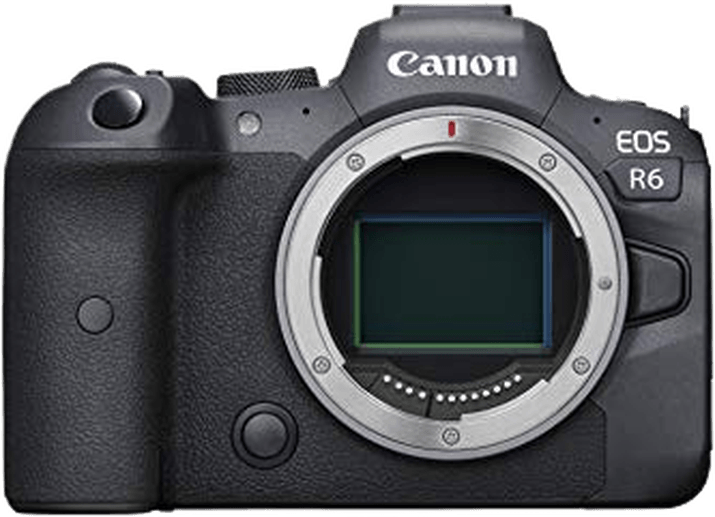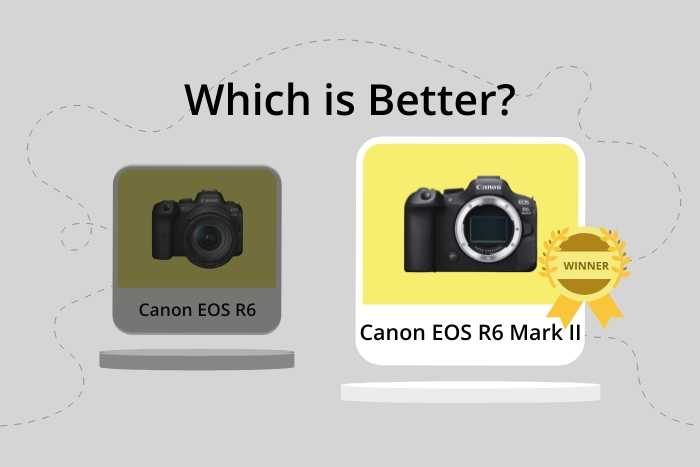Canon EOS R6 vs EOS R6 Mark II Comparison
Canon EOS R6

Canon EOS R6 Mark II

The Canon EOS R6 takes the lead with a score of 80/100, while the Canon EOS R6 Mark II follows closely with 78/100. Both cameras are mirrorless and share the same launch price of $2499. They have similar dimensions, with the R6 measuring 138 x 98 x 88mm and the R6 Mark II at 138.4 x 98.4 x 88.4mm.
The R6 has an edge with its slightly higher score, reflecting its better performance. Launched in 2020, it weighs 680g, which is heavier than its 2022 counterpart, the R6 Mark II, weighing 588g. This difference in weight could be a plus for those who prefer a sturdier camera.
However, the R6 Mark II’s lighter weight at 1.30lbs makes it more convenient for photographers who prioritize portability. Despite its lower score, this advantage may appeal to those with an on-the-go lifestyle.
Weighing the pros and cons of both cameras, the Canon EOS R6’s higher score signifies its better performance, while the R6 Mark II offers more portability with its lighter weight. Ultimately, the choice depends on the user’s preferences and priorities.
Canon EOS R6 vs EOS R6 Mark II Overview and Optics
The Canon EOS R6 Mark II outperforms the Canon EOS R6 in optics with a score of 83/100 compared to 79/100. Both cameras share several specifications, including a CMOS sensor, Digic X processor, full-frame sensor size, Canon RF lens mount, and image stabilization. These common features contribute to the overall quality of each camera.
The Canon EOS R6 Mark II has a higher megapixel count at 24, compared to the Canon EOS R6’s 20.1 megapixels. This difference allows the Mark II to capture more detail and produce higher resolution images. Additionally, the Mark II boasts a shooting speed of 40, doubling the R6’s 20. This increased speed enables the Mark II to capture fast-moving subjects with greater ease. The Mark II also has a slightly higher DXOMARK sensor score of 91, compared to 90 for the R6, indicating marginally better sensor performance.
On the other hand, the Canon EOS R6 is not significantly inferior to the Mark II in terms of optics. The R6’s 20.1-megapixel sensor still produces high-quality images, and its shooting speed of 20 is sufficient for most photography purposes. Its DXOMARK sensor score of 90 is only one point lower than the Mark II, showing that the R6’s sensor performance is still exceptional.
Given these differences, the Canon EOS R6 Mark II is the superior camera in terms of optics, with its higher megapixel count, faster shooting speed, and slightly better sensor performance. However, the Canon EOS R6 remains a strong contender, offering excellent image quality and shooting speed that meets the needs of most photographers.
Canon EOS R6 vs EOS R6 Mark II Video Performance
The Canon EOS R6 outperforms the Canon EOS R6 Mark II in video capabilities, scoring 91 out of 100, compared to the Mark II’s score of 83. Both cameras share common specifications, such as 4K max video resolution and 3840 x 2160 max video dimensions. Additionally, both models offer built-in time-lapse functionality.
The EOS R6 has a significant advantage over the R6 Mark II in terms of max video frame rate, offering 120fps, which is double the 60fps provided by the Mark II. This allows the EOS R6 to capture smoother slow-motion footage and provides more flexibility in post-production for video editors.
While the EOS R6 Mark II does not surpass the EOS R6 in video specifications, it still offers solid video performance with its 4K resolution, 3840 x 2160 dimensions, and 60fps frame rate. These features ensure that the R6 Mark II can produce high-quality videos, despite not matching the EOS R6’s capabilities.
Comparing the video capabilities of the Canon EOS R6 and the Canon EOS R6 Mark II, it is clear that the EOS R6 is the superior choice for videographers, due to its higher video score and increased frame rate. The EOS R6 Mark II, although not as impressive as the EOS R6, remains a suitable option for those seeking a camera with good video performance.
Canon EOS R6 vs EOS R6 Mark II Features and Benefits
The Canon EOS R6 outperforms the Canon EOS R6 Mark II with a feature score of 85/100, compared to the Mark II’s 72/100. Both cameras share several specifications, including a 3-inch screen size, 1,620,000-dot screen resolution, touchscreen capabilities, flip screen, WIFI, and Bluetooth connectivity.
The winning camera, the Canon EOS R6, possesses additional advantages over the Mark II. However, the provided information does not specify these advantages. Based on the higher feature score, it is clear that the R6 offers more benefits to photographers and videographers, making it a better choice for those seeking a versatile and high-quality camera.
On the other hand, the Canon EOS R6 Mark II has one notable advantage over the R6: it features GPS connectivity. This added feature allows photographers to geotag their images, which can be useful for various applications such as wildlife photography, travel photography, and photojournalism. Despite this advantage, the Mark II’s lower feature score indicates that it may not be as well-rounded as the R6 in other areas.
Given the information, the Canon EOS R6 stands as the better camera due to its higher feature score. This score reflects the camera’s overall capabilities and performance, making it a superior choice for those seeking a reliable and feature-rich camera. While the Canon EOS R6 Mark II offers GPS connectivity, this single advantage may not be enough to outweigh the benefits provided by the R6. Therefore, photographers and videographers should carefully consider their specific needs and preferences when choosing between these two cameras.
Canon EOS R6 vs EOS R6 Mark II Storage and Battery
The Canon EOS R6 and Canon EOS R6 Mark II have the same storage and battery score of 68/100. Both cameras offer two memory card slots and accept SD, SDHC, and SDXC cards, with UHS-II compatibility. They share a battery life of 360 shots and use the LP-E6NH battery type. Additionally, both cameras have USB charging capabilities.
The Canon EOS R6 and Canon EOS R6 Mark II are equal in terms of storage and battery performance, as neither camera surpasses the other in any of the specifications mentioned. There are no clear advantages for either camera in this category.
Since both cameras have identical storage and battery scores, they perform similarly in these aspects. This comparison does not provide a definitive winner in terms of storage and battery performance. Therefore, potential buyers should consider other factors, such as general specifications, optics, video, and features, when choosing between the Canon EOS R6 and Canon EOS R6 Mark II.
Canon EOS R6 vs EOS R6 Mark II Alternatives
Still not ready to make a decision? Check out our other popular camera comparisons for inspiration:

